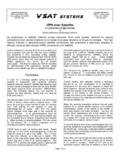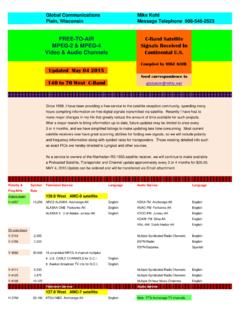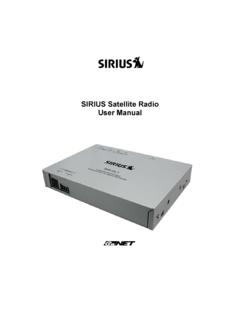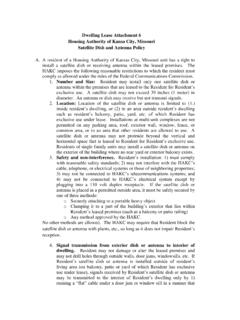Transcription of Add ISS Packet Operation to Your Satellite Activity
1 Add ISS Packet Operation to your Satellite Activity (Use Equipment Already in your Shack .. or Acquire it for Cheap) By JoAnne Maenpaa, K9 JKM Abstract: This article is aimed toward introducing new Amateur Radio Satellite operators to ARISS Packet operations using radio equipment that they may already own. This is intended to be a guide to repurposing their terrestrial equipment for a start on space activities using the strong and predictable downlink of the ISS. Meeting STEM Goals Gets Amateur Radio Aboard the ISS The Amateur Radio station aboard the International Space Station is known as the ARISS program the Amateur Radio on the International Space Station.
2 Many astro-nauts and cosmonauts have amateur radio licenses. Amateurs from the ISS partner countries, in the USA, Russia, Japan, Europe and Canada, have set up the ARISS program to foster amateur radio communications between the astronauts and cosmonauts who reside on the station and stations on the ground. ARISS was the first amateur radio projects to gain access to the International Space Station as it helps NASA fulfill Science, Technology, Engineering, and Math (STEM) goals for education. ARISS is an international educational outreach program partnering the participating space agencies, NASA, Russian Space Agency, ESA, CNES, JAXA, and CSA, with the AMSAT, ARRL, and IARU organizations from participating countries.
3 ARISS offers an opportunity for students to experience the excitement of Amateur Radio by talking directly with crewmembers on-board the International Space Station. Teachers, parents and communities see, first hand, how Amateur Radio and crew members on ISS can energize youngsters' interest in science, technology, and learning. In the current launch environment Amateur Radio in space enthusiasts have discovered that has become nearly impossible to gain a free (or, even low-cost) launch opportunity simply so that a bunch of hams can talk with each other.
4 We generally have to be ready to explain our added value to a launch to even get the ear of the people in charge. The ARISS amateur radio gear on the ISS provides added value in its STEM educational mission. The beneficial side effect for Amateur Radio operators is that the ARISS station remains available for general amateur radio usage when it is not engaged in educational contacts. Since the signal from the ISS is generally very strong this is where you can take advantage of trying your hand on the easiest of the Easy Sats.
5 Easiest of the Easy Sats Where to Listen Knowing where to listen and where to transmit are important first steps to getting started. The table below shows the most common ARISS Amateur Radio frequencies. There are a few additional special modes such as a MHz FM uplink that are rarely, if ever utilized. School contacts use the MHz downlink with unpublish-ed uplink frequencies used at the school site. The most commonly used ISS Amateur Radio frequencies are summarized in the table below. Many hams spend a lot of time listening for ISS crew Activity on the strong MHz downlink.
6 They often express disappoint-ment that no FM voice Activity had been heard for weeks. Crew Activity depends a lot on their time available plus personal interest in making random contacts. Some prior crews made voice contacts frequently while use of the ARISS amateur radio gear is limited to school contacts for other Commonly Used ISS Amateur Radio Frequencies Mode V APRS (Worldwide APRS Digipeater) Uplink MHz FM 1200 BPS Downlink MHz FM 1200 BPS Mode U APRS (Worldwide APRS Digipeater) Uplink MHz FM 1200 BPS Downlink MHz FM 1200 BPS Mode V/V Crew Contact (Regions 2 & 3) Uplink MHz FM Downlink MHz FM Mode V/V Crew Contact (Region 1) Uplink MHz FM Downlink MHz FM Mode U/V (B)
7 FM Voice Repeater (Worldwide) Uplink MHz FM Downlink MHz FM Mode V SSTV Imaging Downlink MHz FM Packet is Where Its At (most often it seems) Packet Activity from the ISS is often noted on the MHz downlink. The uplink is on the same MHz frequency. Since the crew rarely engages in keyboard contacts, most of the Packet Activity you are hearing is originated from earth stations using the ARISS digipeater. Lacking Packet gear you will only hear the brzzzzz-brap sound of the 1200 baud audio frequency shift keyed (AFSK) signal.
8 You will need to know when the ISS is within range of your station. Refer to the appendix Know When to Listen Tracking Resources. Getting on the air with the ARISS Packet digipeater can likely be accomplished with amateur radio gear you already own. No special amateur radio equipment beyond what is used for terrestrial contacts is needed to begin taking your first steps toward Amateur Radio in space. This means if you do not own certain items they can likely be acquired inexpensively. Think of ARISS Packet radio as regular ham radio (including Packet ) aimed skyward.
9 The good news is once you have equipped your station for ARISS Packet and learned the ropes for ARISS Operation your station will be ready for those rare voice contacts with the ISS crew. You will just need to switch the Packet gear for a microphone and start calling. Get your Station Going on MHz Packet When Packet radio was popular on VHF/UHF many years ago you may have acquired your Terminal Node Controller (TNC) which you interfaced to your FM radio. There were many Packet bulletin board systems and personal Packet mailboxes that were accessible via your TNC.
10 That Activity has diminished over time, having been replaced by the internet. You may have a TNC sitting on the shelf collect-ing dust. This same old hardware, capable of operating 1200 baud AFSK modulation is still useful for Packet radio Operation via the ISS. There were many models of the TNC including: MFJ-1270C TNC-2 Packet Controller Kantronics KPC-3 TNC If you don t a TNC that you used in the old days , these can often be purchased rather inexpensively at a hamfest. When you see a good deal, grab it if you prefer the hardware approach to Packet Operation .








